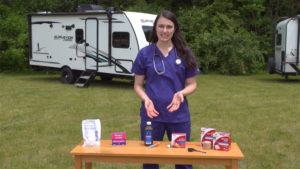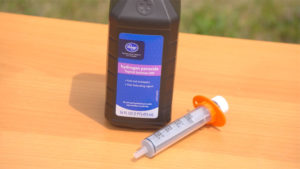rving with pets
Introducing Dr. Fitz for 'Paws on Board'
I’m Dr. Fitz. This is Theo. Today we’re gonna be talking about pet first aid kits. Most of us enjoy being able to take our pets on the road. We come prepared with their food, water, toys, leash, everything they might need along the way. But what if there’s an emergency? Do you have supplies with you to quickly care for your pet?
In this segment, I’ll be going over some of the items that you should pack with you to make a first aid kit for your pet. This list is not exhaustive, but it will contain items that you would need to help your pet in common situations. These items are also meant to provide care to your pet quickly so you have time to get them to a veterinarian.
 Your pet should always be examined by a veterinarian if there’s a medical emergency. All of the items that you see here on this table would be important to include in a pet first aid kit. First, clean gauze, Coban, scissors, and a non-adherent dressing are important to have in your kit. If your pet sustains a wound, you can quickly cover it to protect it from further contamination while you transport your dog to a vet. The non-adherent dressing is important so that the bandage doesn’t stick to the wound. That can be really painful when it has to be removed later. The layers that you’ll want to include on a bandage: first, you’ll place the non-adherent dressing against the wound, then you’ll have some gauze for padding and to absorb any blood. And then you’ll have your Coban which is a self-adhesive-type bandage to hold your bandage material onto the wound.
Your pet should always be examined by a veterinarian if there’s a medical emergency. All of the items that you see here on this table would be important to include in a pet first aid kit. First, clean gauze, Coban, scissors, and a non-adherent dressing are important to have in your kit. If your pet sustains a wound, you can quickly cover it to protect it from further contamination while you transport your dog to a vet. The non-adherent dressing is important so that the bandage doesn’t stick to the wound. That can be really painful when it has to be removed later. The layers that you’ll want to include on a bandage: first, you’ll place the non-adherent dressing against the wound, then you’ll have some gauze for padding and to absorb any blood. And then you’ll have your Coban which is a self-adhesive-type bandage to hold your bandage material onto the wound.
Again, wound covers are temporary only and are a means to protect the wound while you transport your pet to a veterinarian. Antiseptic wipes and triple antibiotic ointment are also helpful to be able to clean and dress small cuts that your dog might sustain when playing or hiking.
 Second, hydrogen peroxide and a medication dosing syringe are important to have in your kit. If your pet ingests something toxic as dogs are prone to do, such as chocolate, unknown berries, anything like that on the trail, or even animal bait, it can be life saving to make your pet vomit and get those items out of their stomach. Hydrogen peroxide works as an irritant to the stomach lining and causes dogs to throw up. You should contact your veterinarian for the dose of peroxide that’s appropriate for your dog. Vomiting is most effective within about 30 to 60 minutes of ingestion. So if it’s been longer, get your pet to a veterinarian immediately for treatment. You should not attempt to give peroxide more than twice in one episode. As I said, it’s a stomach irritant. High doses of peroxide can cause severe irritation to the stomach lining and actually lead to more problems later on. If the peroxide doesn’t work, get your pet to a veterinarian for treatment. A word of caution: if your pet has ingested something that makes them dizzy, sleepy, or in any way not responsive, you should never give them anything by mouth. This can lead to choking or even inhaling the hydrogen peroxide. If your pet is not acting normally, they need immediate medical attention.
Second, hydrogen peroxide and a medication dosing syringe are important to have in your kit. If your pet ingests something toxic as dogs are prone to do, such as chocolate, unknown berries, anything like that on the trail, or even animal bait, it can be life saving to make your pet vomit and get those items out of their stomach. Hydrogen peroxide works as an irritant to the stomach lining and causes dogs to throw up. You should contact your veterinarian for the dose of peroxide that’s appropriate for your dog. Vomiting is most effective within about 30 to 60 minutes of ingestion. So if it’s been longer, get your pet to a veterinarian immediately for treatment. You should not attempt to give peroxide more than twice in one episode. As I said, it’s a stomach irritant. High doses of peroxide can cause severe irritation to the stomach lining and actually lead to more problems later on. If the peroxide doesn’t work, get your pet to a veterinarian for treatment. A word of caution: if your pet has ingested something that makes them dizzy, sleepy, or in any way not responsive, you should never give them anything by mouth. This can lead to choking or even inhaling the hydrogen peroxide. If your pet is not acting normally, they need immediate medical attention.
 Next, Benadryl. Super important to have in any first aid kit. If your pet’s stung by a bee, eats a bee as dogs tend to do, or starts to have an allergic reaction, starting Benadryl and being able to give that with antihistamines is important to help reduce that allergic reaction. Check with your vet for Benadryl dosing that’s appropriate for your dog. Some allergic reactions can be very severe and lead to facial swelling and closure of the airways. This can be a medical emergency and requires immediate veterinary attention. For milder reactions, if you’ve given Benadryl and aren’t seeing much improvement within about an hour, your pet may need additional medications to reduce that reaction. So, again, contact your veterinarian.
Next, Benadryl. Super important to have in any first aid kit. If your pet’s stung by a bee, eats a bee as dogs tend to do, or starts to have an allergic reaction, starting Benadryl and being able to give that with antihistamines is important to help reduce that allergic reaction. Check with your vet for Benadryl dosing that’s appropriate for your dog. Some allergic reactions can be very severe and lead to facial swelling and closure of the airways. This can be a medical emergency and requires immediate veterinary attention. For milder reactions, if you’ve given Benadryl and aren’t seeing much improvement within about an hour, your pet may need additional medications to reduce that reaction. So, again, contact your veterinarian.
Next, tweezers are essential to help remove any ticks that may have hitched a ride on your pet. Always thoroughly check your dog for ticks each day, making sure to check behind and in the ears, between the toes and the paw pads, and on the face. There are also commercial tick removers available that make removing ticks fairly easy. Finally, an instant cold pack can be beneficial to have on hand. If your pet sustains an injury, you can start icing the area right away or you can help your dog cool off on hot days. These are just some of the items that I would include in a pet first aid kit that can be immensely helpful on the road. Hopefully, this information allows you to travel comfortably and safely with your pet. For more information about traveling safely with your pets, visit rollinontv.com.
Tune in next time for more pet health information. I’m Dr. Fitz, this is Theo. Thanks for watching Paws on Board.


